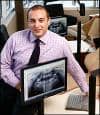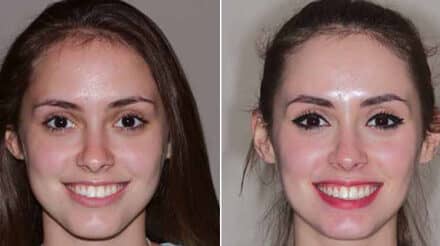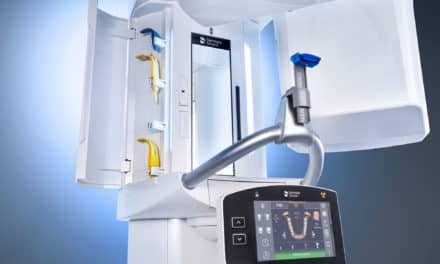byLori Sichtermann
How Mohammad R. Razavi, DDS, MSD, FRCD(C), rebuilt the architecture and technology of his practice
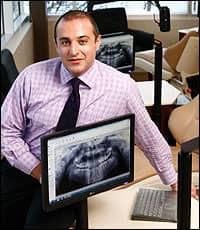
The first impression that Mohammad R. Razavi, DDS, MSD, FRCD(C), got of the orthodontic profession was not a positive one. He was 14 years old when his parents took him to an imposing office managed by a stoic practitioner. Frightened by the idea of tooth removal and the onslaught of braces, Razavi revolted.
On their second attempt, Razavi’s parents took their son to the office of Neil Shapera, DDS, where the teenager’s orthodontic anxieties were quickly resolved. As Razavi explains today, Shapera was smiling, laughing with his patients, and having genuinely a good time. “Throughout my treatment with Shapera, his demeanor never changed, which made a lasting impression on me,” Razavi recalls. “I remember thinking how cool it would be to actually enjoy what you do for a living.”
It was the lasting impression of his own orthodontic experience that led Razavi to study dental medicine and ultimately practice orthodontics. Over the years, Razavi has practiced and taught in the United States, and has lectured to orthodontic audiences around the globe.
Today, Razavi is busy adding “architect” to his long list of credentials. Having acquired, remodeled, and revolutionized an orthodontic practice in Kanata, Ontario, Canada, the doctor has been hard at work applying a style of orthodontics that is known to provoke a smile or two.
Practice Made Perfect
PRACTICE PROFILE
Practice Name: Palladium Orthodontics
Location: Kanata, Ontario, Canada
Specialty: Temporary anchorage devices
Patients per day: 85–90
Starts per year: 440
Years in private practice: 6
Days in privatepractice per week: 4
Web site: PalladiumOrthodontics.com
In the early weeks of 2009, after nearly a decade’s worth of dental school, teaching gigs, and practicing orthodontics in Cleveland (where he also served as orthodontist for the Cleveland Browns), Razavi was ready to make the move to warmer climates … and practices.
“I was moments away from signing the paperwork to start a new practice in Atlanta,” he recalls. “I was done with the cold weather. I was going to burn all my winter clothes, buy a convertible, and drive it year-round. Then, I got a call from a friend in Toronto. She asked me to take a look at a practice in Ontario.”
The practice in question was located in Kanata. Intrigued by the idea of being closer to his family and joining a practice that was already established and respected, Razavi capped his poised pen and agreed to tour the Ontario practice.
“I walked into the clinic and took a look around. I couldn’t get past the dated equipment and the dated dÉcor,” Razavi explains. “I saw the next 20 years of my life flash before my eyes. I saw the potential the practice had and how I could renovate it to make it more efficient. I could make it the practice I’ve always wanted.”
Razavi took over the practice and renamed it Palladium Orthodontics in March 2009. Although he was eager to hit the ground running with his new practice, Razavi knew that in order to continue the success of the business and ensure its future growth, the transition would have to be slow and carefully orchestrated.

Razavi dedicated the first 6 months at his new practice to getting to know his new team.
“From the beginning, I knew this wasn’t going to be something that I could walk in and start making all kinds of changes to. That’s just a recipe for disaster,” Razavi says. “So I broke it down into three phases. By making small steps, the transition was a lot smoother on me, the staff, and the patients.”
As Razavi explains, he spent the first 6 months getting to know the existing team, the referring dentists, and the patients. Then he brought in his style of brackets and treatment mechanics, and trained the staff how to use the new technology. “At the 1-year mark, we brought in Dolphin practice-management software and started the process of making the office completely paperless.”
By September 2010, it was time for the third phase of Razavi’s transition plan: a complete interior makeover. This was a major undertaking that consisted of three distinct subphases and a lot of careful planning. As Razavi explains, the demolition and reconstruction had to take place during office hours.
“The company we hired to do the renovation had to work around us and our patients,” Razavi notes. “It’s not like, as an orthodontist, you can tell your patients, ‘Sorry. We’re going to be under construction for 2 1/2 months, so if you have an emergency, don’t call us.’ I wanted to be available to my patients at all times.”
The physical changes to Palladium Orthodontics were dramatic. “There is actually only one wall that remains from the old setup,” he says. “In every way imaginable, we changed the practice.”
Razavi redesigned the office using nothing more than a few sheets of paper and a ruler. The layout now is more accommodating to patients and staff. In the previous layout, there was only 2,553 of square feet of workable space, which featured four patient workstations. Although the office’s square footage remained the same, its redesign allowed for nine additional patient workstations.
The workspace expansion within the office aligns with Razavi’s ultimate plan to equip the practice for the future. “I want it to be able to handle the growth I expect from the office,” he says. “I wanted to place the practice at the leading edge of technology as well as orthodontic treatment.”
Tech Tactics

Razavi and his team at Palladium Orthodontics have more room to work in their newly refurbished office.
For Razavi, the chance to take over an existing practice rather than build a new one was a career-advancement tactic. “When you take over a practice, you’re taking over an established cash flow,” he explains. “When you open a new practice, you lose money in the beginning hoping patients will walk through the door. I was 5 years into my career, and I wanted to hit the ground running.”
With an appointment book full of patients-in-progress, Razavi was able to make some dramatic changes to his new practice. While the structural changes are the most apparent, Razavi also significantly improved the way the office handles patients and their treatments.
After a year of learning how Palladium Orthodontics operated, Razavi introduced advanced technology that aligned with the office operations, yet made day-to-day aspects more efficient. “We do digital radiography that’s upgradable to 3D imaging,” Razavi says. “We also integrated digital models so as to eliminate the need for extra storage space. This process is more efficient in terms of legalities regarding records. We want to be the only orthodontic practice in Ontario that does not take an actual impression of teeth. At Palladium, we are preparing to use a scanner that scans the arches. ”
As Razavi explains, his practice has made it standard practice to do digital presentations for patients and their parents. “Parents appreciate this feature because they can actually see the treatment that we’re recommending,” he adds. “The child likes it, too, because they can get an idea of what to expect. When we talk to patients, they often comment that the visual demonstration was perfect—it was exactly what they wanted to see.”
The Patient Experience
The motivation behind each of the changes Razavi has made to Palladium Orthodontics stems from his desire to create a positive experience for his patients. “We run a patient-centered practice,” Razavi explains. “We never forget who we work for. If the patient stops walking through the door, my staff and I don’t have a job.”
For Razavi, communication is what makes the difference between a good and bad experience. “I spend a lot of time at the consultation making sure a patient understands why we are doing what we’re doing,” he explains. “Over the years, I’ve only had one complaint from a parent that I ignored them during the patient consultation, and only paid attention to their child. I take that as a compliment, really. At my consultations, I make sure I engage the child in the treatment and process from Day 1.”
Patients and their parents also can expect to receive verbal reports after each visit, which, as Razavi explains, wards off confusion and anxiety. “Patients are told at each appointment where they stand in terms of the treatment,” he says. “There are no surprises. And, when there are no surprises, there are no negative feelings toward our office or the procedure.”
In addition to open lines of communication, Razavi also has compassion for his patients. Every patient who gets appliances put on for the first time will receive a call from Razavi personally after his or her appointment so the doctor can check in and answer any questions.
Practice What You Teach
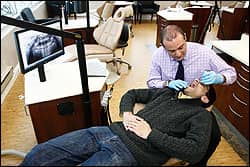
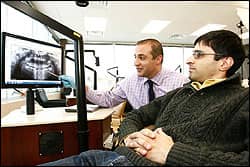
In addition to managing a successful practice, Razavi also takes his show on the road, so to speak. Almost immediately after he received a Doctor of Dental Surgery degree and a Master’s Degree in Orthodontics from Case Western Reserve University in Cleveland, Razavi began teaching at his alma mater. Currently, he acts as a visiting assistant clinical professor at the university, where he teaches advanced courses on treatment techniques.
In combination with the demands of his practice, Razavi considers teaching a fulfilling outlet as well as a necessary advancement in his profession. “Teaching forces me to stay up to date on the latest materials and budding knowledge in orthodontics,” he explains. “As a professor, you have to keep up on all the recent knowledge and techniques. Questions from residents are some of the toughest I’ve ever gotten. They look at problems differently than an orthodontist who has been practicing for 10 or 15 years.”
When asked how he keeps current with techniques and technology, Razavi answers with a slight laugh, “I don’t sleep.” When pressed to confess, he admits to making time for the medical and trade journals that cross his desk. Razavi also is an advocate for enrolling in continuing education classes in order to stay abreast of new trends and technology in the field.
“When I started practicing, there were no temporary anchorage devices or 3D imaging,” he says. “We had to teach ourselves how to use new products, visualize treatments plans, and treat our patients in a different way than we were taught as recently as 5 years ago.”
When in front of his own classroom, Razavi prepares his students for technology coming down the pipeline. He also gives them advice on how to be a compassionate orthodontist. “It’s not just about straight teeth. It’s about inclusion and treating each patient in a way that they will never forget. I didn’t forget my orthodontist or the experience I had with him,” he says. “I’m passionate about what I do for a living and how I live my life. When I look a back on all that I’ve done, I’m proud to say that I enjoy what I do every day. And that’s a wonderful feeling.”
Lori Sichtermann is a contributing writer for Orthodontic Products. For more information, contact
Oral Presentations
By 2007, Razavi was well established in his career and his technique. Through his experiences practicing and teaching, he became an enthusiastic advocate of the 3M Unitek brand of products. It was at this time that the company asked Razavi if he would lecture on behalf of its products.
“I feel very passionate about the 3M products, and I believe in them,” he says. “When they asked me to share my experiences and share the learning curve I experienced when introduced to the technology, I was happy to do so.”
According to Razavi, his talks focus on temporary anchorage devices (TADs), treatment mechanics, and how to vary mechanics when using TADs instead of conventional headgear and braces.
“I also talk a lot about using SmartClip brackets from 3M for a 100% self-ligating practice,” Razavi adds. “I’m very passionate about providing an efficient treatment plan. I believe there is no reason a patient should be in treatment longer than 18 to 24 months.”
In addition to giving talks about 3M’s technology, Razavi speaks on behalf of the company’s Bottomline Orthodontic Resident program. In these lectures, he focuses on practice management, treatment management, and office efficiency.
Razavi’s connection with 3M Unitek has taken him to lecture halls and hotel ballrooms throughout North America and the world. As an advocate for the company, he’s adamant about making sure his audience understands his motive for each lecture. “I make it clear that just because I’m speaking for 3M doesn’t mean I get my products for free,” he explains. “I pay the same as anyone else out there.”
Instead, Razavi travels twice a month to various locations around the globe because of genuine goodwill toward the company and its products. “I’m drawn to the quality of the products,” Razavi explains. “3M has very rigorous standards when it comes to product development and the material they put out. And, as an orthodontist, I appreciate the work they do.”
As an orthodontist who centers his practice on customer service, Razavi was impressed long ago by 3M’s customer care. As he explains, his first dealings with the company made a lasting impression on him. “When I was a resident, I was learning a lot and I had a lot of questions. The staff at 3M was always there nurturing me and helping me,” Razavi notes. “My connection with 3M has a lot to do with the relationship I have with them. I don’t look at myself as a sales rep for 3M—I’m a satisfied client.”
—LS

